
B369-Young-Learners-Activity-Book_v10
.pdf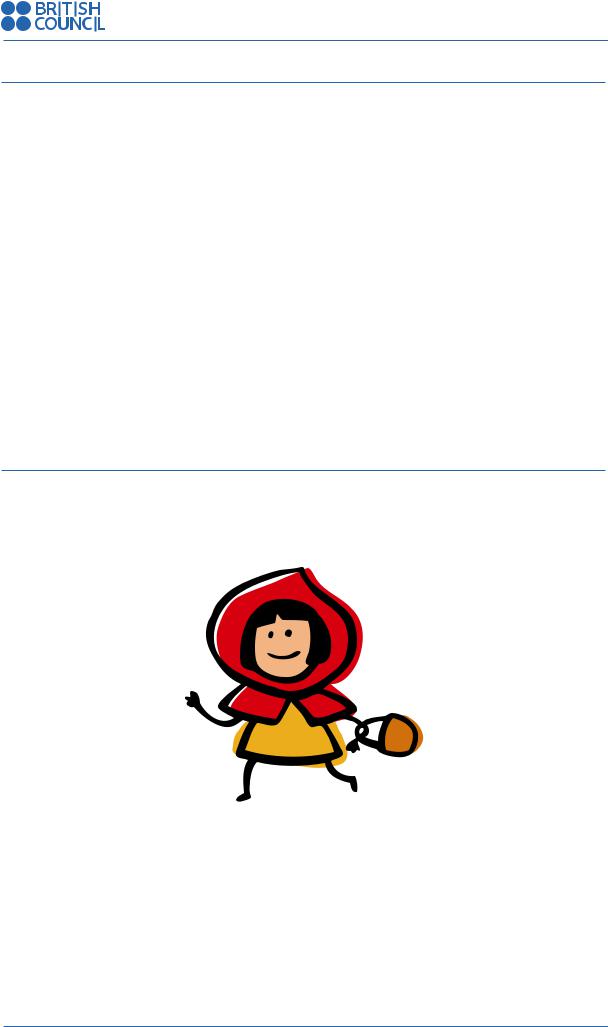
TeachingEnglish Young Learners Activity Book
Activities
Alternatives
•There are many follow up activities you could do with this story. For example, children could draw and colour the characters and practise writing their names; they can be asked to retell the story in pairs or small groups; they can change the story by suggesting a different ending or adding in new characters.
•Vesna Sarvevic (Spain) suggests that after telling the story, you stick up large posters round the classroom. Each poster has a hand written section of the text, with gaps. Each child then receives either a picture or a word and walks to the poster to fill one of the gaps. The children walk around the classroom reading the texts. When they find the gap that their word or picture fits, they stick it on the poster. (Alternatively, the teacher can read each text in turn with the students coming up to the front when they think their word fits the gap.) Finally the complete text is read out.
•This activity presents just some of the ways in which stories can be exploited in the YL classroom. Any children’s’ story can be used, not just fairy-tales. If you have access to the internet, there are many sites with the words of stories and often with illustrations, audio and/ or video versions. Two reliable sites are the BBC children’s site, CBeebies, which can be found at: http://www.bbc.co.uk/cbeebies/stories/theme/fairytales/ and The British Council site: http://learnenglishkids.britishcouncil.org/en/short-stories
No resources?
Use objects or draw them on paper to pre-teach the vocabulary.
If you don’t have access to the internet or to story books, you can use local folk tales and translate them into English.
© British Council 2012 |
49 |
|
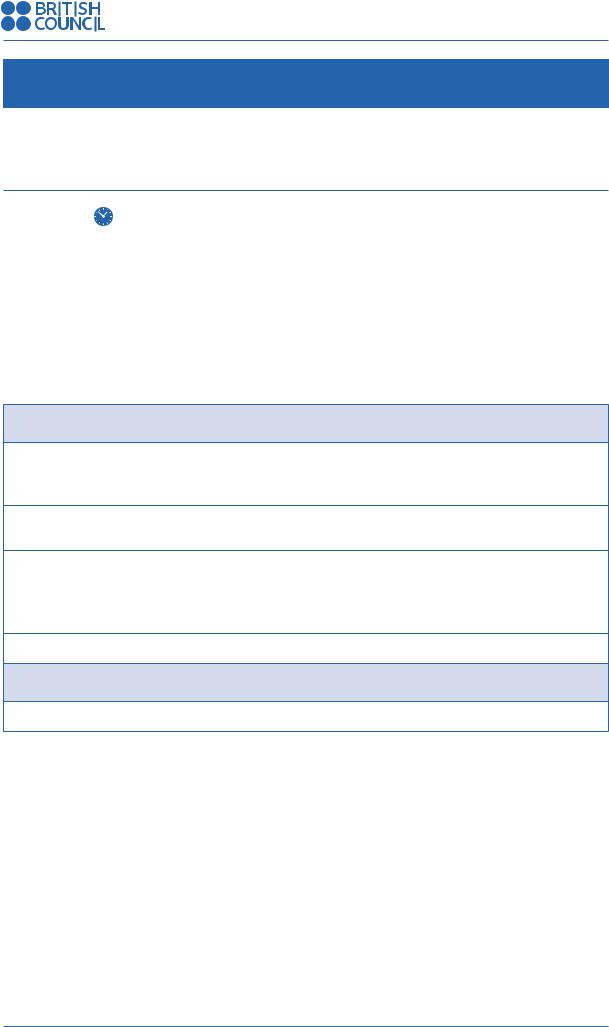
TeachingEnglish Young Learners Activity Book
Activities
Activity 22: Chain games
Eliana Fernandez Malla – Dominican Republic and
Jekaterina Mazure – Latvia
Age: All ages |
20–30 minutes Large classes? No Mixed level? Yes |
Materials: Flashcards.
Organisation: Whole class.
Aim: To practise or revise a new vocabulary set.
Description: Children sit in a circle. They learn a new vocabulary set (for example, vegetables). They then take turns to repeat a shopping list and add new items to it.
Preparation: You will need to prepare flashcards of the words you want the children to learn.
Procedure
1.Introduce a set of words you want the children to learn, for example fruit and vegetables, through flashcards. After practising the pronunciation, stick the card on to the board (you might want to write the word under the card).
2.Ask the children to sit in a circle. Explain they will have to use the flashcards to try to remember a list of words.
3.Introduce the phrase, ‘My auntie went to market, and she bought an apple’. The first child should add to the list, using another word from the flashcards, in the following way: ‘My auntie went to market and she bought an apple and some carrots’. The activity goes on with each child adding to the list after having repeated all the items before.
4.Repeat the activity, but this time take the flashcards off the board and erase any writing.
Notes
You can help children who are struggling by mouthing the words in the list.
50 |
© British Council 2012 |
|
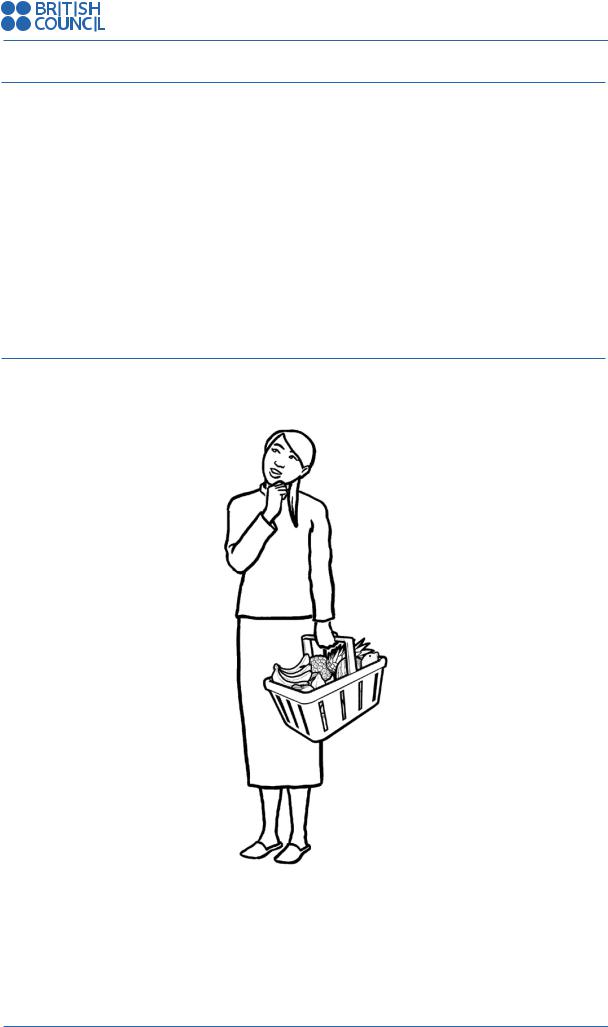
TeachingEnglish Young Learners Activity Book
Activities
Alternatives
•It is not necessary to teach a set of vocabulary first. The children can add whatever they like to the list from words they remember. This takes much less time.
•Another alternative is to start the next item in the list with the last letter of the previous item. For example, ‘I went to market and bought an apple, an elephant, some trees and a snake’.
•Add a rhythm. Model the rhythm by slapping your knees (gently) twice, clapping (twice)
and then clicking the fingers on each hand in turn. Get all the children to take up the rhythm. Then say your own name on the first click and one of the children’s names on the second. The child then says their name on the first click and another child’s on the second. Once the rhythm has been established, introduce a word family, for example, fruit. The activity starts again, but this time you say a fruit with the first click and a name of a child with the second. For example, ‘banana, Peter’. Peter then has to say, for example, ‘apple, Justina’, and so on.
No resources?
You do not need the flashcards. You can play the game using words the children already know or you can use the course book to teach the words you want them to know.
© British Council 2012 |
51 |
|
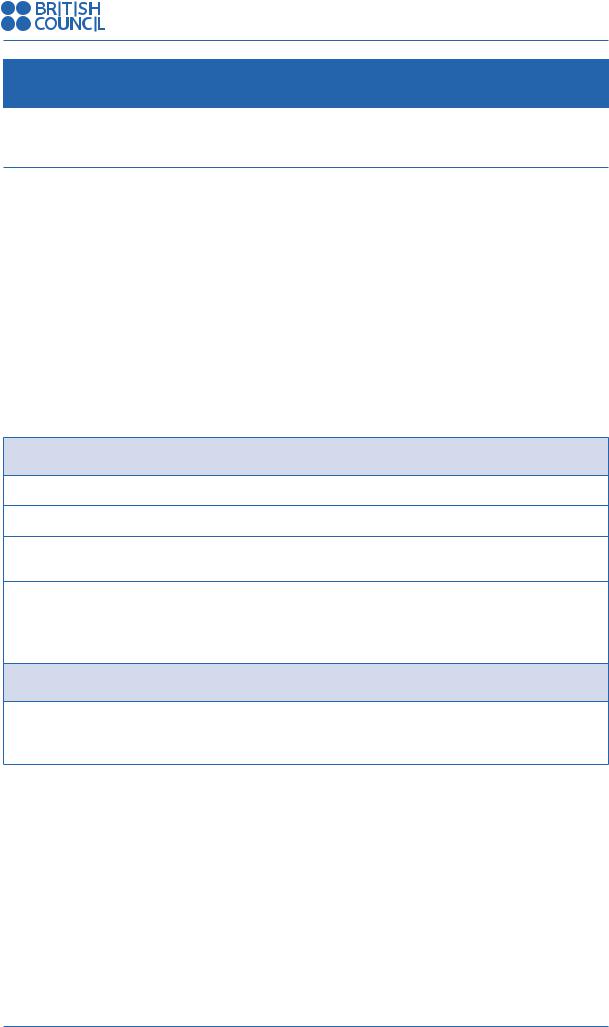
TeachingEnglish Young Learners Activity Book
Activities
Activity 23: Memory game
Ester Bianchi – Italy
Age: 6 –10  30 minutes Large classes? Yes Mixed level? Yes
30 minutes Large classes? Yes Mixed level? Yes
Materials: Sets of cards with words and drawings/pictures of fruit (or other vocabulary group), one set for each group of four.
Organisation: Group work, whole class.
Aim: To introduce and practise vocabulary, to practice pronunciation.
Description: This is an adaption of the classic card-matching game sometimes called Pelmanism. In this version the children have to find picture/word combinations, but there are a number of variations.
Preparation: You will need to create sets of cards – at least 14 cards in each set. To explain the activity we are using fruit as the vocabulary set, but you can choose whichever vocabulary you like. On seven cards draw/stick pictures of fruit and on the other seven, write the names of the fruit.
Procedure
1.Show the picture cards to the children and repeat the words all together.
2.Show the children the word cards with the picture cards and repeat again.
3.Divide the class into groups of four and give each group a set of cards. One child in each group shuffles the cards and lays them face down on the desk.
4.The children take it in turns to turn over two cards to try and find a picture-word pair. If the child is successful, they say the name of the fruit and take the card and turns over two more cards. If they are not successful, the cards are turned face down again and the next child has a turn. The child with the most cards at the end is the winner.
Notes
In activities where the children are working in groups, especially in competitive games such as this one, it can useful to nominate one child in each group as the group leader and give them responsibility for leading the activity and monitoring it.
52 |
© British Council 2012 |
|
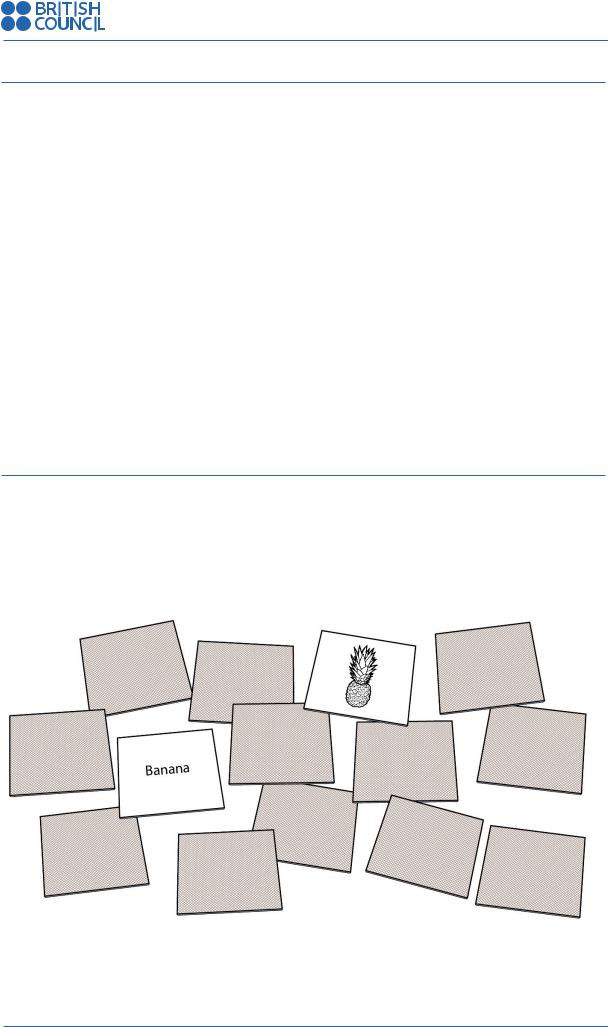
TeachingEnglish Young Learners Activity Book
Activities
Alternatives
•This game can be played with any vocabulary set. It can also be played with sound / letter pairs, such as the letter ‘C’ and a picture of a car.
•The same game could be played with question/answer pairs or with matching sentence halves to practise grammar points. For example, matching tenses and adverbs: one set of cards has time adverbs such as yesterday, l, twice a day, since 2000, next week. The other set has phrases such as I went to the doctor’s, I’m not feeling very well, I brush my teeth, I’ve been at this school, I’m going to the USA.
•The children can draw the pictures on pieces of paper/card in preparation for the game.
•Gulanara Janova (Georgia) suggests another game with cards which she calls ‘Fishing’. Put the prepared vocabulary picture cards, or objects into a box or bag. Ask the children to come to the front one at a time to pick a picture/object out of the bag/box – tell them they are ‘catching a fish’. The child who has caught a fish has to name it. If they name it correctly,
they take it back to their seat. If they cannot name it, they have to put it back in the bag/box. The child with the most ‘fish’ at the end is the winner. This activity can also be used to revise/ practise grammar, for example, children can describe their picture (e.g. ‘It’s a big, black cat’) or say what their classmates have caught (e.g. ‘I have a cat, Dana has a horse, Ivan has a duck and Josi has a lion.’).
No resources?
Make one set of cards and either play as a whole class or bring a group to the front to play while the others watch. Alternatively, call 14 students to the front and tell seven they are fruit pictures and seven that they are fruit names. Ask them to sit down. Children from the class call out pairs, for example, ‘Mohammed is an apple picture and Ali is an apple word’. If they are correct, they get a point. If not, the turn moves to another child.
© British Council 2012 |
53 |
|
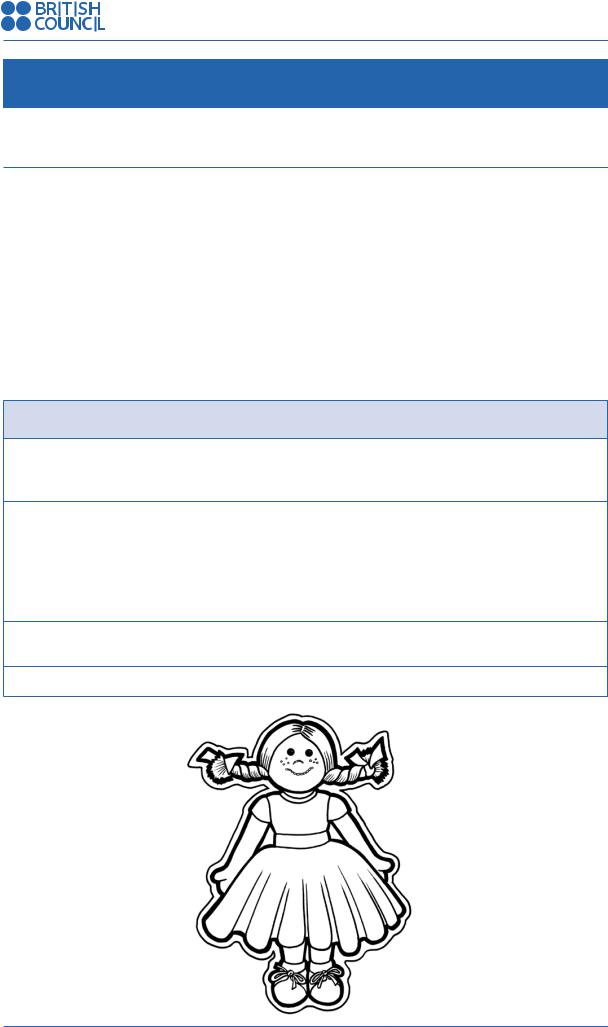
TeachingEnglish Young Learners Activity Book
Activities
Activity 24: Messy closet
Jelena Čupić – Serbia
Age: 8-10  30 minutes Large classes? Yes Mixed level? Yes
30 minutes Large classes? Yes Mixed level? Yes
Materials: Paper dolls, paper clothes, an outline of a closet/wardrobe. Organisation: Individual, pair and group work.
Aim: To revise vocabulary related to clothes and expressions of place. To practise reading for detail.
Description: In this activity the children have to ‘tidy’ up a closet by reading a description of its contents and putting the clothes in the correct place.
Preparation: You will need to prepare a paper doll, and for each group, some glue and a set of paper clothes.
Procedure
1.Use the paper doll to introduce a character to the children. Give it a name or ask the children to name it. Tell the children this character is very untidy and they are going to help tidy up its wardrobe (closet).
2.Give each child/pair or group a large A3 picture with the outline of an empty closet, including shelves, hanging rail etc. together with a description of what the tidy closet should look like and the paper clothes that need tidying, for example: My t-shirts go on the top shelf on the right. My jeans go on the bottom shelf on the left. My shoes go in the bottom of the wardrobe, under my jeans. My belts and ties hang on the wardrobe door. On the middle shelf I put my underwear. Trousers go on the top shelf next to the t-shirts.
3.The children read the description of the tidy closet and stick the items of clothing in the correct place.
4.The children put their tidy closet on the board or wall and compare their work with others.
54 |
© British Council 2012 |
|

TeachingEnglish Young Learners Activity Book
Activities
Notes
Although it is time-consuming to create the doll, wardrobe and clothes, if you can laminate all the paper items and use blu tac or sticky tape to stick rather than glue, then the materials can be re-used for this activity, with a different text, and for other activities.
Alternatives
•Give the children a list of the relevant items of clothing, ask them to find pictures and cut them out. This could be done as a homework activity.
•You could also describe the closet to the children and ask them to draw it as part of the activity.
•This activity can be extended to a writing activity by asking the children to draw a picture and write a description of their own closet.
•It can also be a listening activity if you choose to read the text out loud rather than giving it to the children.
•Jelena also suggests another activity which can be done with paper dolls. This activity is called My Nutty Family.
1.Model the activity by presenting the imaginary character. Use a doll, picture or drawing to present the character and to say something about their life.
2.Give out a slip of paper with the name of a family member to each child or pair of children. Give each child or pair a paper doll and a selection of accessories.
3.The children think of the background story to their character – who they are, what they do, where they live and so on. They then dress their paper doll according to the character they have invented. Encourage them to be creative and funny.
4.The children take it in turns to come to the front and talk about their character using the first person. Encourage them to make connections with what others have said before them to link the characters together.
•Geneviève Parrain (France) suggests using a paper doll or puppet to introduce the class to a new class member.
1.On slips of paper (one for each child) write a piece of information about the new class member. For example, ‘I am 10 years old’, ‘I like apples’, ‘I live in a small house’, ‘I have two brothers and two sisters’, and so on.
2.Introduce the doll as the new class member.
3.Explain to the children they are each going to get one piece of information about the new class member. They have to memorise the information and then remember information that their classmates tell them.
4.The children walk around the class and exchange information about the new class member. They then sit down and write as much as they can remember about the new classmate. The child who remembers most is the winner.
No resources?
Do this as a whole class activity with one set of clothes. Children take it in turns to put the clothes away and say/write where they have put the clothes. Or ask the children to imagine their closet/ shelf at home and to say where things are.
© British Council 2012 |
55 |
|
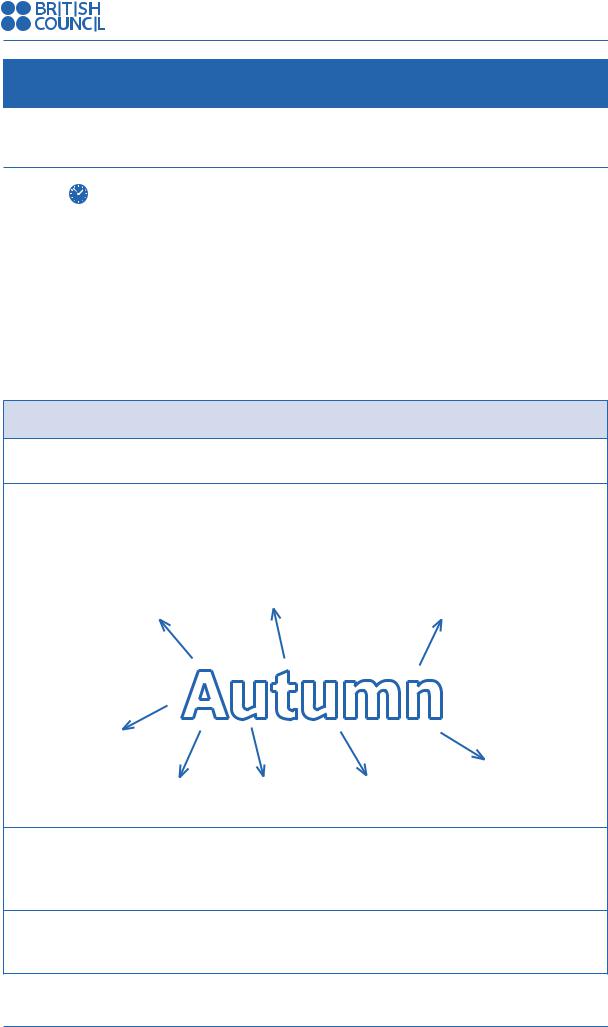
TeachingEnglish Young Learners Activity Book
Activities
Activity 25: My seasons’ book
Ludmilla Koval – Ukraine
Age: 7–9 |
30 – 40 minutes once a season over a year Large classes? Yes Mixed level? Yes |
Materials: A blank booklet of ten pages for each child (five A3 pieces folded and stapled is ideal). Coloured pens /crayons /pencils /glue, items from nature (such as leaves), any other materials to decorate (for example, glitter).
Organisation: Whole class.
Aim: To practise vocabulary and writing, particularly creative writing. Description: The children prepare booklets about the four seasons. Preparation: No preparation is needed for this activity.
Procedure
1.In the first lesson of ‘My Seasons Book’, ask the children to write the title on the front cover and to put their name on. They can decorate it as they wish.
2.In the second lesson, write the name of the season you are experiencing on the board, for example, AUTUMN. Create a mind-map of all the things the children associate with this season in your country. If they do not know the English word, provide a translation. Here is an example:
|
gold and brown leaves |
cold |
fireworks |
Autumn
toffee apples
long nights
October bonfires November
3.The children then write Autumn in the centre of their second page and they can either copy what is on the board, or they can write their own words around the season (for example, they could write the months that are in autumn). The children then decorate the page, for example, with dry leaves.
4.For the next page, prepare a poem, a song or a story about autumn. Again, you can either do this as a class activity, building up the text on the board that children then copy into their books, or the children can write their own story or poem, or choose one of their own.
56 |
© British Council 2012 |
|

TeachingEnglish Young Learners Activity Book
Activities
5.At the beginning of each season, repeat the sequence of activities until the children have a complete ‘My Seasons’ book.
Notes
During the year as the books are being compiled, you can display them in the classroom or students can take them home to show their families.
Alternatives
•You could make this a monthly activity. You would obviously need more pages in the blank booklet.
•Rather than preparing individual booklets, the children could make posters in groups. Split the class into four groups and allocate a season to each (or let the groups choose). The children then design and create a poster containing key sections (such as key words, a poem, some drawings, a story). The posters are then displayed in the classroom.
No resources?
Make one poster for the whole class. Groups of children can be responsible for one section, or you can select the best pieces of writing from the class and add them to the poster. Alternatively, the children could learn a short piece to represent each season. Here are some ideas from the CanTeach website – www.canteach.ca/elementary/songspoems.html
November
No sunshine, lots of rain,
No warm days, snow again!
No bugs or bees
No leaves on trees.
You must remember
This is November!
Summer
The snow fell gently all the night It made a blanket soft and white
It covered houses, flowers and ground But did not make a single sound.
Springtime
A small green frog On a big brown log;
A black and yellow bee In a little green tree;
A red and yellow snake By a blue-green lake, All sat and listened
To red bird sing, ‘Wake up, everybody, It’s spring! It’s spring!’
Summer
In the summer when the days are hot, I like to find a shady spot,
And hardly move a single bit And sit, and sit, and sit, and sit.
© British Council 2012 |
57 |
|
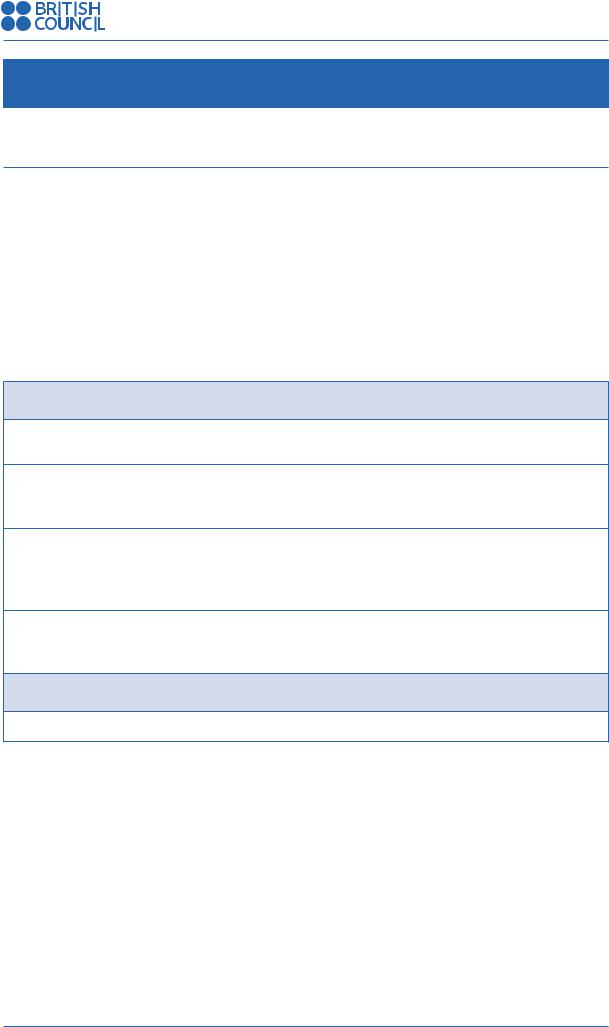
TeachingEnglish Young Learners Activity Book
Activities
Activity 26: Numbers and words
Frosina Acevska – Macedonia
Age: 7–11  25 minutes Large classes? Yes Mixed level? Yes
25 minutes Large classes? Yes Mixed level? Yes
Materials: Flashcards with pictures on, magnets or tape and pen/chalk. Organisation: Whole class activity.
Aim: To revise new vocabulary and numbers.
Description: The teacher uses flashcards to revise vocabulary. The children then have to remember the vocabulary items and write them in their workbooks.
Preparation: You will need 20 picture flashcards representing vocabulary you want to revise.
Procedure
1.Use the flashcards to chorally drill the vocabulary. When the children are confident saying the word from the flashcard, stick it on to the board and give it a number from 1 to 20.
2.Read out a number, for example 7. The child who identifies flashcard number 7 by saying the word, collects the card from the board and keeps it. Continue until all the flashcards have been collected.
3.Now you have to get the cards back. To do this, write the words on the board one by one, or show a flashcard of the written word only. The child who has the corresponding picture says the word and puts the picture back on the board next to the correct number. They then write the word on the board next to the picture.
4.When all the pictures are back on the board, the children choose five words they want to remember. They then write the words in their vocabulary notebooks /workbooks and draw pictures to illustrate them.
Notes
You can do this activity with any number of cards from 5 –20.
58 |
© British Council 2012 |
|
